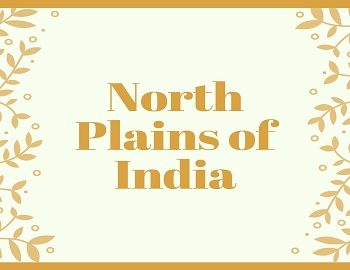Table of Contents
North Plains of India:
The North Plains are flat and symmetrical throughout the stretch of the plains though local variations in altitude do exist. On the basis of these variations, they are divided into the following subdivision-
The Indus Basin:
The Western portion of the North Plains in which the Indus and its tributaries like the Jhelum, the Chenab, the Beas and the Ravi flow, is situated in Jammu and Kashmir, Punjab and H.P. The Indian portion of this basin also extends from the Aravali range to the Pakistan border. This plain has two distinctive regions- one of the desert and the other of bangar deposits.
The south-west portion of Rajasthan is commonly known as the Thar Desert. It has been formed by wind action. Here and there sand dunes are seen all over the desert. Small lakes called Dhand are found near Jaisalmer. The other region known as the Bangar region is situated in the north-east of Rajasthan. The Luni drains this region. Ambala is situated on the water divide between the Indus and the Ganga Plains.
The Ganga Plain:
The Ganga plain covers Haryana, Uttar Pradesh, Bihar and West Bengal. The Ganga and its tributaries have formed this plain. The plain south of the Yamuna is the depositional work of the Chambal, Betwa, Ken and Son. The plain abounds in narrow valleys and deep ditches and is known as bad land. The central plain of Uttar Pradesh, formed by the Ramganga, the Sharda and the Gomati is called Rohilkhand plain. The north-east plain of Uttar Pradesh has been formed by the Ghaghra and the Gomti rivers. It is known as the Awadh plain. The stretch of the Ganga plains between Allahabad and the Bay of Bengal is the lower-valley of the Ganga.
The Brahmaputra Valley:
The Brahmaputra river, as long as the Indus, originates near the source of the Indus and the Satluj in Tibet. Its major portion lies in Tibet. It flows parallel to the Himalayan mountain ranges in Tibet. Around Namcha Barwa it takes a hairpin turn and enters India in Arunachal Pradesh. After this, it flows through Assam and Bangladesh before confluencing with the Bay of Bengal. The river is known by different names in different parts of its courses-
| Portion | Name |
|---|---|
| Tibet | Tsangpo |
| Arunachal Pradesh | Dihang |
| Assam (after the confluence of Lohit, Dihang and Dibang) | Brahmaputra |
| Northern Bangladesh | Jamna |
| Central Bangladesh | Padma |
| Southern Bangladesh | Meghna |
The Brahmaputra has under-cut its bed in Arunachal Pradesh and Assam by 5500 metres which looks quite unbelievable. The river carries a huge volume of water and silt and has contributed a lot to the formation of the Ganga-Brahmaputra Delta which is the largest delta in the world.
The Ganga-Brahmaputra Delta:
The Ganga and the Brahmaputra have formed the largest delta of the world on the mouth of the Bay of Bengal, comprising the southern portion of Bangladesh and Sundarbans portion of India in West Bengal. This delta is the fastest growing and most fertile delta. The Ganga and the Brahmaputra after joining together have split into numerous rivulets, know as distributaries. The lower portion of the delta has become marshy because the freshwater of the river and the salty water of the sea get mingled here during the high and low tides.









Comments (No)